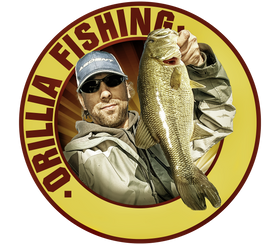Part 2 of a 3 part series for Orillia Fishing By Wil Wegman
February 2022
Last month, in part one of our series on Backcountry ice fishing trips found here we introduced you to what these are all about, how to find out where to go and provided you with some pre-planning suggestions. Now that February is upon us … let’s get ready to head up north and actually begin our wilderness lakes ice fishing adventure and see if we can help maximize your experience and get you on some fish. However, before you leave the house be sure to consider the following:
- Who are you going with? As much as I love solo fishing … backcountry trips do come with more risk and heading in with a buddy or two is the way to go.

- Find out if there will be cell service available
- Access- Is there a trail leading into the lake you chose? If so, do snowmobiles regularly travel it … or do you need to snowshoe in?

- Not everyone has a snowmobile but if you do it can offer vastly more opportunities. Relying on just one sled increases the risk it will break down or - just as bad, become engulfed in slush when out on the lake. Both incidents are far more common than you’d think and therefore having two snowmobiles offers much greater peace of mind.
- You may consider snowshoeing instead … even if there is a hard packed snowmobile trail … those snowshoes will help you check out different areas on the lake where deep snow could abound
- A good Safety Kit is important – and should include a First Aid Kit, tools/spare belt for your sled, Duct tape, small shovel, hatchet, flashlight, emergency blanket, tarp, lighter, tow/safety rope, spud bar, winch for snowmobile, spare socks even a change of clothes. Consider a charging device like the Simcoe Power Box to ensure your cell phone, electronics and other devices remain fully charged
- When considering what backcountry lake to ice fish, place higher value on those surrounded by other potential hotspots nearby. Despite being secluded and often times with little angling pressure, even the best wilderness lakes can shut down one day, whereas the lake next door for whatever reason is on fire. Same deal with species targeted – for instance many times we have counted on the usual amazing brook trout action in one lake, only to learn by mid-afternoon we have yet to get bit. A quick jaunt to a productive splake lake however would yield us a limit by dusk!

In our final installment of this series later this month, we will cover in detail a species by species bag of tricks to help you increase your odds at catching any one them. For now however, based on some generalities here are some tips that should work for a variety of cold water species like splake, brookies and lakers. Figuring out where on the lake to fish can be daunting if you studied a google earth image. So - it’s a good idea to glass it with a good set of bino’s to identify key areas to fish. Seeing old holes can be obvious however be forewarned that they can also be the cause of major slush in that immediate
area – so keep well back.
Then look for shoreline features that should indicate prime areas to set up. Obvious main lake points are a no brainer – but more subtle secondary points can be sleeper locations that many overlook. Beaver houses can be brookie and splake magnets and should never be overlooked … especially if they are active. How to tell? Look for tracks or slides and or freshly cut branches often stored in a food plot directly in front of the beaver house. Fishing around fallen timber along shore can be great … but the key is to determine if the branches are actually long enough and deep enough to reach close to bottom. Standing timber is not as common but when present should not be over looked – especially if in water deep enough to hold fish. There’s one lake we like to
fish for lakers south of Gogama where we’d routinely catch them in 10’ of water right near those trees!

These winter vacations are not just about the fishing but a combination of getting there, traveling to and from lakes, enjoying shore lunches, the evenings in the cabin or camp, recounting the day’s catches, and of course reveling in the remote beauty of northern Ontario. And the best part is your exciting adventure begins the moment you leave your front door!

- 30 -
Wil Wegman is an award winning outdoor writer whose articles have appeared in most Canadian and several US Outdoor publications. He is an avid ice angler and educator and his ice fishing seminars across Ontario and into the US have helped thousands get bit through the ice. Wil was inducted into the Canadian Angler Hall of Fame in 2017 and continues to be a strong advocate for conservation and the fishing community.

